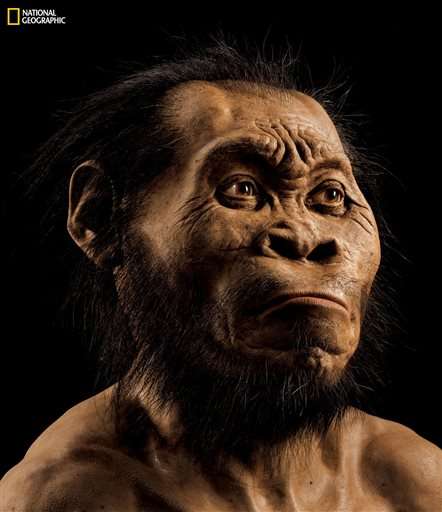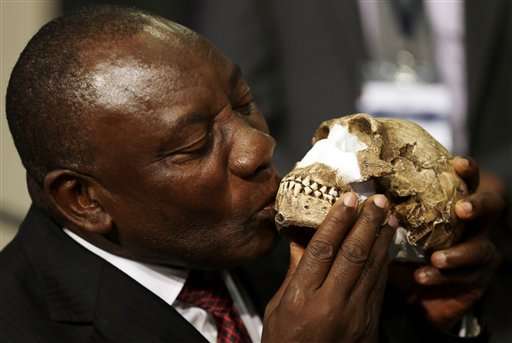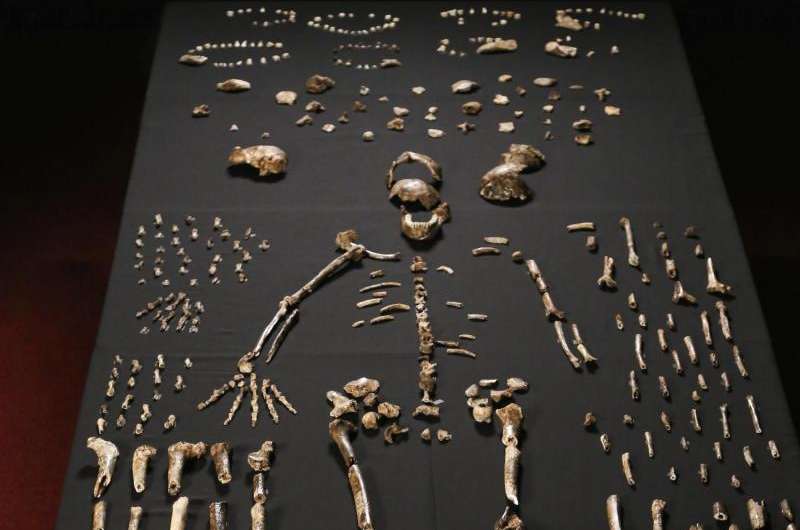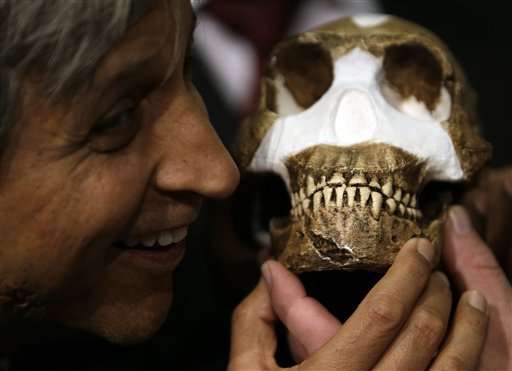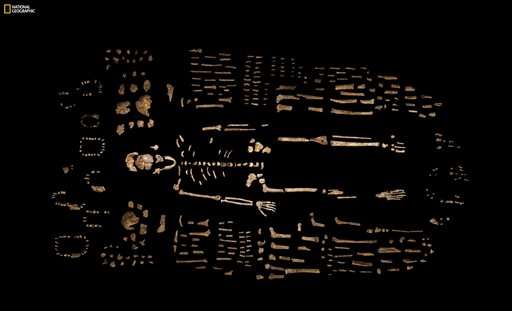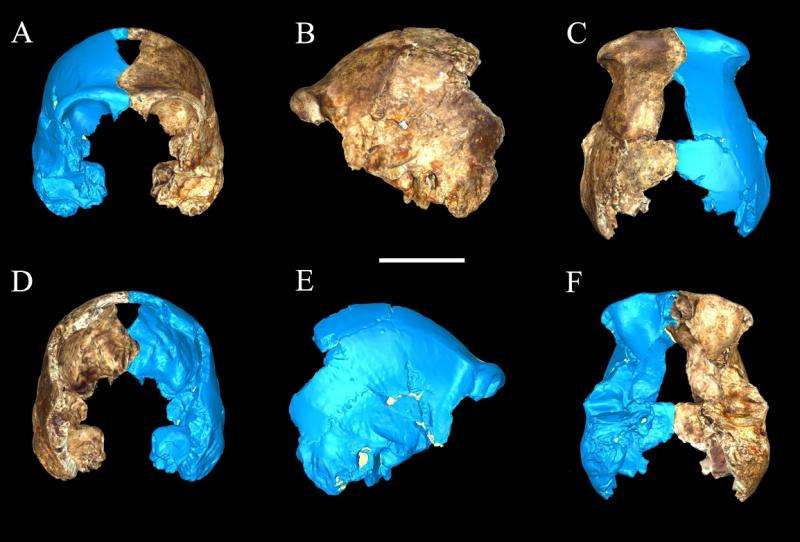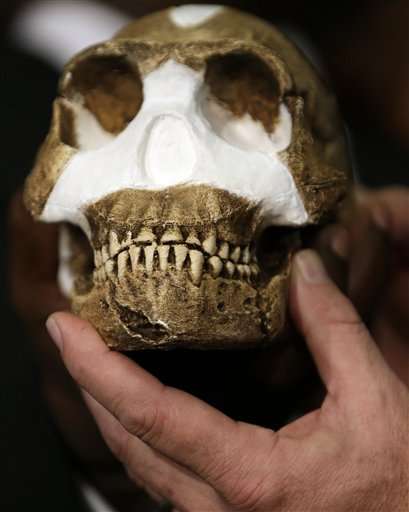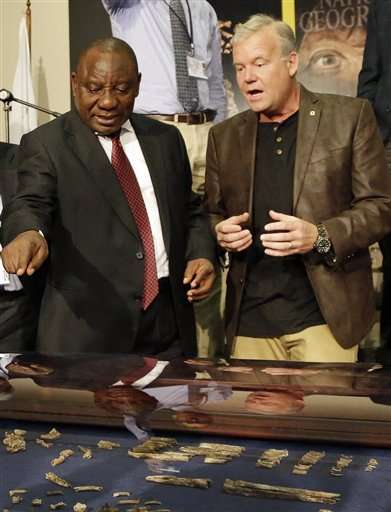This March 2015 photo provided by National Geographic from their October 2015 issue shows a reconstruction of Homo naledi's face by paleoartist John Gurche at his studio in Trumansburg, N.Y. In an announcement made Thursday, Sept. 10, 2015, scientists say fossils found deep in a South African cave revealed the new member of the human family tree. (Mark Thiessen/National Geographic via AP)
Scientists say they've discovered a new member of the human family tree, revealed by a huge trove of bones in a barely accessible, pitch-dark chamber of a cave in South Africa.
The creature shows a surprising mix of human-like and more primitive characteristics—some experts called it "bizarre" and "weird."
And the discovery presents some key mysteries: How old are the bones? And how did they get into that chamber, reachable only by a complicated pathway that includes squeezing through passages as narrow as about 7½ inches (17.8 centimeters)?
The bones were found by a spelunker, about 30 miles (48 kilometers) northwest of Johannesburg. The site has yielded some 1,550 specimens since its discovery in 2013. The fossils represent at least 15 individuals.
Researchers named the creature Homo naledi (nah-LEH-dee). That reflects the "Homo" evolutionary group, which includes modern people and our closest extinct relatives, and the word for "star" in a local language. The find was made in the Rising Star cave system.
The creature, which evidently walked upright, represents a mix of traits. For example, the hands and feet look like Homo, but the shoulders and the small brain recall Homo's more ape-like ancestors, the researchers said.
Lee Berger, a professor at the University of the Witwatersrand in Johannesburg who led the work, said naledi's anatomy suggest that it arose at or near the root of the Homo group, which would make the species some 2.5 million to 2.8 million years old. The discovered bones themselves may be younger, said Berger, an American.
South Africa Deputy President Cyril Ramaphosa, kisses a reconstruction of Homo naledi's face during the announcement made at Maropeng Cradle of Humankind in Magaliesburg, South Africa, Thursday, Sept. 10, 2015. Scientists say they've discovered a new member of the human family tree, revealed by a huge trove of bones in a barely accessible, pitch-dark chamber of a cave in South Africa. (AP Photo/Themba Hadebe)
At a news conference Thursday in the Cradle of Humankind, a site near the town of Magaliesburg where the discovery was made, bones were arranged in the shape of skeleton in a glass-covered wooden case. Fragments of small skulls, an almost complete jawbone with teeth, and pieces of limbs, fingers and other bones were arrayed around the partial skeleton.
Berger handed a skull reconstruction to Deputy President Cyril Ramaphosa, who kissed it, as did other VIPs. Berger beamed throughout the unveiling.
Skeletal fossils of Homo naledi are pictured in the Wits bone vault at the Evolutionary Studies Institute at the University of the Witwatersrand, Johannesburg, South Africa, on Sept. 13, 2014. The fossils are among nearly 1,700 bones and teeth retrieved from a nearly inaccessible cave near Johannesburg. The fossil trove was created, scientists believe, by Homo naledi repeatedly secreting the bodies of their dead companions in the cave. Analysis of the fossils -- part of a project known as the Rising Star Expedition -- was led in part by paleoanthropologist John Hawks, professor of anthropology at the University of Wisconsin-Madison. Credit: John Hawks/University of Wisconsin-Madison
The researchers also announced the discovery in the journal eLife. They said they were unable to determine an age for the fossils because of unusual characteristics of the site, but that they are still trying.
Berger said researchers are not claiming that neledi was a direct ancestor of modern-day people, and experts unconnected to the project said they believed it was not.
Professor Adam Habib, holds a reconstruction of Homo naledi presented during the announcement made in Magaliesburg, South Africa, Thursday, Sept. 10, 2015. Scientists say they've discovered a new member of the human family tree, revealed by a huge trove of bones in a barely accessible, pitch-dark chamber of a cave in South Africa, showing a surprising mix of human-like and more primitive characteristics. (AP Photo/Themba Hadebe)
Rick Potts, director of the human origins program at the Smithsonian Institution's Natural History Museum, who was not involved in the discovery, said that without an age, "there's no way we can judge the evolutionary significance of this find."
If the bones are about as old as the Homo group, that would argue that naledi is "a snapshot of ... the evolutionary experimentation that was going on right around the origin" of Homo, he said. If they are significantly younger, it either shows the naledi retained the primitive body characteristics much longer than any other known creature, or that it re-evolved them, he said.
Skeletal fossils of the hand of Homo naledi pictured in the Wits bone vault at the Evolutionary Studies Institute at the University of the Witwatersrand, Johannesburg, South Africa, on Sept. 13, 2014. The fossil hand is one of many fossils representing a new species of hominin. The broad thumb of Homo naledi suggests it was an expert climber. The Rising Star Expedition, a project that retrieved and analyzed the fossils was led in part by paleoanthropologist John Hawks, professor of anthropology at the University of Wisconsin-Madison. Credit: John Hawks/University of Wisconsin-Madison
Eric Delson of Lehman College in New York, who also wasn't involved with the work, said his guess is that naledi fits within a known group of early Homo creatures from around 2 million year ago.
This photo provided by National Geographic from their October 2015 issue shows a composite skeleton of Homo naledi surrounded by some of the hundreds of other fossil elements recovered from the Rising Star cave in South Africa, photographed at the Evolutionary Studies Institute of the University of the Witwatersrand in Johannesburg, South Africa. In an announcement made Thursday, Sept. 10, 2015, scientists say the fossils revealed the new member of the human family tree. The expedition team was led by Lee Berger of the university. (Robert Clark/National Geographic, Lee Berger/University of the Witwatersrand via AP)
Besides the age of the bones, another mystery is how they got into the difficult-to-reach area of the cave. The researchers said they suspect the naledi may have repeatedly deposited their dead in the room, but alternatively it may have been a death trap for individuals that found their own way in.
"This stuff is like a Sherlock Holmes mystery," declared Bernard Wood of George Washington University in Washington, D.C., who was not involved in the study. Visitors to the cave must have created artificial light, as with a torch, Wood said. The people who did cave drawings in Europe had such technology, but nobody has suspected that mental ability in creatures with such a small brain as naledi, he said.
These are bone fragments of Homo neladi, a new species of hominin recently discovered in South Africa by a team of scientists including Anthropologist Charles Musiba of the University of Colorado Denver. Credit: Charles Musiba
Potts said a deliberate disposal of dead bodies is a feasible explanation, but he added it's not clear who did the disposing. Maybe it was some human relative other than naledi, he said.
Not everybody agreed that the discovery revealed a new species. Tim White of the University of California, Berkeley, called that claim questionable. "From what is presented here, (the fossils) belong to a primitive Homo erectus, a species named in the 1800s," he said in an email.
At the news conference in South Africa, Berger disputed that.
"Could this be the body of homo erectus? Absolutely not. It could not be erectus," Berger said.
A reconstruction of Homo naledi presented during the announcement made in Magaliesburg, South Africa, Thursday, Sept. 10, 2015. Scientists say they've discovered a new member of the human family tree, revealed by a huge trove of bones in a barely accessible, pitch-dark chamber of a cave in South Africa, showing a surprising mix of human-like and more primitive characteristics. (AP Photo/Themba Hadebe)
Q&A: South African fossils said to reveal new human relative
Researchers said Thursday that they had discovered a previously unknown relative of humans, revealed by bones found deep in a South African cave. Here's a quick look at the discovery:
WHAT DID THEY FIND?
They recovered some 1,550 fossils, from the skeletons of at least 15 individuals. The cave is about 30 miles northwest of Johannesburg.
HOW OLD ARE THE BONES?
Nobody knows. The researchers said they've been unable to get a date, but that they will keep trying.
WHAT IS THIS CREATURE?
Based on details of the bones, the scientists say in the journal eLife that it's new to science but a member of the evolutionary group called Homo, which includes modern people and our closest extinct relatives. The anatomy combines traits found in other Homo species with more primitive ones. The researchers conclude it's an early member of Homo, but they don't claim it's a direct ancestor of modern people. Experts said they don't believe it is.
Lee Berger, a professor at the University of the Witwatersrand, right, presents to South Africa Deputy President Cyril Ramaphosa, right, the of the hundreds of other fossil elements recovered from a cave during the announcement at Maropeng Cradle of Humankind in Magaliesburg, South Africa Thursday, Sept. 10, 2015. Scientists say they've discovered a new member of the human family tree, revealed by a huge trove of bones in a barely accessible, pitch-dark chamber of a cave in South Africa. (AP Photo/Themba Hadebe)
WHAT DO THEY CALL IT?
Homo naledi (nah-LEH-dee). The second name, which means "star" in a local language, was chosen because the bones were found in the Rising Star cave system.
HOW DID THE BONES GET INTO THE CAVE?
That's a mystery. They were found in a room that can be reached only by following a complicated pathway and squeezing through narrow passages. There's no sign that naledi lived there. The bones evidently were not dragged in by predators. Maybe the room was used to dispose of bodies, the researchers suggest.
More information: eLife: elifesciences.org/
© 2015 The Associated Press. All rights reserved.
